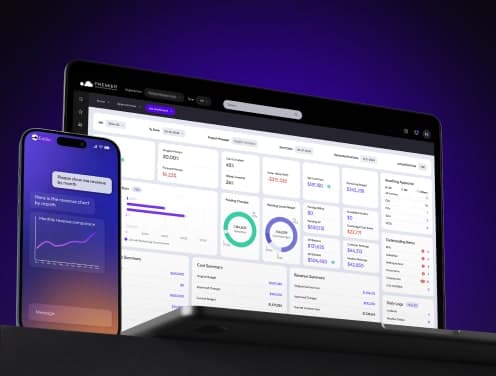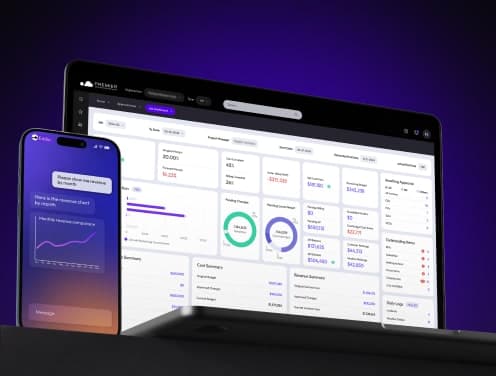
How to Create Time and Materials Billing for Construction Projects
A time-and-material contract forms the backbone of many construction projects where the scope remains flexible. In fact, these legally binding agreements outline how you'll get paid for both your labour hours and the materials used on a project. Unlike fixed-price agreements, T&M contracts allow contractors to bill for actual hours worked and materials used instead of committing to a predetermined cost.
When managing construction projects with unpredictable elements, understanding time and materials agreements becomes crucial for your bottom line. Contractors typically add a markup between 15% and 35% on these projects, though some construction materials markups range from 10% to 30%. This billing approach lets you focus on profits while dealing with the unpredictable nature of contracting.
In this comprehensive guide, we'll explore what a time and materials contract is, how it differs from fixed-price models, and the best practices to protect your profits. We'll also look at practical examples and strategies to maximize your T&M billing efficiency with the right tools and processes.
What is a Time and Materials Contract?
Time and materials (T&M) contracts establish a payment framework based on two core components: the actual hours worked and materials used to complete a construction project. Under this arrangement, you pay contractors for their labour at predetermined hourly rates plus the cost of materials, often with an added contractor markup.
The fundamental structure of a T&M contract includes:
- Labour rates: Fixed hourly rates covering wages, overhead, administrative expenses, and profit for each labour category
- Material costs: Actual expenses for all materials used in the project
- Markup percentage: Contractors typically add 15-35% markup to cover overhead and profit
- Documentation requirements: Detailed tracking of time spent and materials used
For construction business owners, this contract type provides transparency about where every dollar is allocated. You receive comprehensive documentation of all expenses throughout the project lifecycle, creating accountability between you and your contractors.
How it differs from fixed-price contracts
The primary distinction between T&M and fixed-price contracts lies in how financial risk is distributed. In a fixed-price (lump sum) contract, contractors agree to complete all specified work for a predetermined amount regardless of how much time or materials they ultimately use.
Fixed-price contracts place most financial risk on contractors, who must estimate costs accurately beforehand. Consequently, contractors often include risk contingencies in their pricing to protect themselves from unexpected expenses.
Furthermore, with T&M contracts, the final project cost remains flexible until completion, whereas fixed-price contracts establish the total cost upfront. This fundamental difference affects project management, client relationships, and profitability strategies.
T&M contracts provide greater financial protection for contractors because you're compensated for all work performed, even if scope changes or unexpected conditions arise. Additionally, they require less upfront assessment since payment isn't tied to specific performance milestones.
When to use a T&M contract in construction
T&M contracts shine in situations where estimating accurate costs proves challenging. Consider this approach particularly for:
Early-stage projects with undefined scopes where requirements may evolve. During initial planning phases, T&M contracts allow work to begin without waiting for complete specifications.
Renovation work where hidden conditions might emerge once construction begins. Older buildings often reveal unexpected challenges that would make fixed-price contracts risky.
Projects under tight time constraints where the schedule takes priority over cost certainty. When commercial obligations require immediate action, T&M contracts facilitate swift mobilization.
Complex construction with unpredictable elements that make accurate estimation difficult. Large-scale projects with numerous variables benefit from the flexibility T&M provides.
Maintenance operations that require ongoing support, where the exact scope fluctuates. This approach allows you to pay only for the actual person-hours needed to complete maintenance tasks.
Nevertheless, T&M contracts require proper management. Without adequate oversight, they may create incentives to extend project timelines, which could lead to increased costs. To mitigate this risk, many construction professionals incorporate "not-to-exceed" clauses that establish a maximum payment ceiling.
Premier Construction Software helps contractors manage T&M contracts effectively by tracking labour hours, material costs, and change orders in real-time, ensuring you maximize profitability while maintaining client trust.
Key Components of a Time and Materials Agreement
Every successful time-and-materials contract contains five essential components that protect both contractors and clients. Understanding these elements helps you craft agreements that safeguard profits while maintaining transparency throughout your construction projects.
Labour rates and categories
Structured labour costs form the foundation of any time and materials agreement. Your contract must specify separate fixed hourly rates for each labour category, including wages, overhead, administrative expenses, and profit markup. Most contracts categorize workers based on skill level and specialization, with different rates for each group.
For effective labour rate structures:
- Define all labour categories (project managers, skilled trades, general labourers)
- Include loaded labour rates covering base wages plus overhead
- Set different rates for contractors, subcontractors, and affiliated companies
- Consider including maximum labour hours to prevent budget overruns
Premier Construction Software lets you track these categories automatically, ensuring accurate billing across all worker classifications.
Material costs and markup
Material pricing in T&M contracts typically includes actual costs plus a standard markup percentage. This markup—usually between 15% and 35%—covers overhead and profit margin. Your contract should clearly outline how materials will be billed, including:
- Direct material costs (concrete, lumber, paint)
- Associated expenses (freight, taxes)
- Standard markup percentage
- Documentation requirements for all materials
- Process for handling returned materials
To maximize profitability, keep detailed records of all material purchases with corresponding receipts.
Not-to-exceed clauses
A not-to-exceed (NTE) clause limits the client's financial liability by establishing a maximum project cost. This provision offers clients budget certainty while still allowing for the flexibility of a time-and-materials billing structure.
An effective NTE clause should:
- State the maximum contract value in clear terms
- Outline procedures for approaching the limit
- Specify what happens if costs threaten to exceed the cap
- Require contractor notification when nearing the ceiling
- Detail the process for adjusting the NTE amount if necessary
This clause essentially combines T&M flexibility with fixed-price budget protection, making it attractive to cautious clients.
Billing frequency and documentation
Clear payment terms prevent disputes and ensure steady cash flow. Your time and materials contract should stipulate exactly when and how you'll be paid. Consider including:
- Invoicing frequency (weekly, monthly)
- Required documentation (timesheets, receipts, material invoices)
- Payment due dates after invoice submission
- Acceptable payment methods
- Potential milestone-based billing options
Construction billing software streamlines this process by automatically generating compliant invoices with all required documentation attached.
Change order process
Change orders modify scope, cost, or timeline within an existing agreement. For time-and-materials contracts, your change order process must be meticulously documented.
A well-defined change order process includes:
- Written documentation requirements for all changes
- Approval workflows and required signatures
- Impact assessment on both cost and schedule
- Integration with existing not-to-exceed provisions
- Clear distinction between T&M changes and contract changes
With properly structured components, your time and materials contracts protect profit margins while providing the flexibility needed for complex construction projects. This balanced approach keeps both parties informed throughout the project lifecycle.
Time and Material Contract vs Fixed Price and Other Models
Comparing contract types helps you choose the right payment model for your construction projects. Each type offers distinct advantages, depending on your project's needs and risk tolerance.
T&M vs Fixed Price
Fixed-price contracts lock in total project costs upfront, making them fundamentally different from flexible time-and-material arrangements. Under a fixed price model, you agree to complete all work for a set amount regardless of actual costs incurred. This shifts most financial risk to you as the contractor.
The key differences include:
- Risk distribution: Fixed price places risk primarily on contractors; T&M distributes it more evenly
- Budget certainty: Clients gain predictability with fixed pricing but sacrifice flexibility
- Change management: T&M adapts easily to scope changes; fixed price requires formal change orders
- Profit protection: T&M ensures profit through markup rates (typically 15-35%)
Fixed-price contracts work best for well-defined, smaller projects with predictable requirements. On the other hand, T&M shines when the scope remains fluid or when quick mobilization takes priority over cost certainty.
T&M vs Cost-Reimbursable
Both T&M and cost-reimbursable (cost-plus) contracts cover actual project expenses, but they calculate profit differently. In cost-plus contracts, you bill for direct and indirect costs plus a separate predetermined fee or percentage. This contrasts with T&M's approach of embedding profit within marked-up labour and material rates.
Cost-plus contracts often appeal to clients prioritizing quality over cost and contractors looking to minimize financial risk. Moreover, many government and defence agencies prefer cost-plus agreements due to their transparency requirements.
Both models require detailed expense tracking and documentation, although their administrative burdens differ slightly depending on how profit calculations are performed.
T&M vs Guaranteed Maximum Price (GMP)
A guaranteed maximum price contract establishes an upper limit for project costs—typically about 25% above what you might bid on a fixed price basis. When combined with T&M billing, this creates a hybrid approach offering flexibility with a safety net.
Under a GMP arrangement, you assume responsibility for expenses exceeding the cap. However, most GMP contracts include provisions for sharing cost savings if the project finishes under budget. This creates an incentive to complete work efficiently while still protecting the client from runaway expenses.
GMP contracts position you as a Construction Manager at Risk (CMAR), overseeing the project from start to finish with financial consequences for budget overruns. For clients, this arrangement provides greater peace of mind than pure T&M billing because the maximum price is predetermined before construction begins.
Ultimately, each contract type allocates risk differently between you and your clients. Choosing wisely means balancing flexibility against budget certainty while protecting your profit margins.
Pros and Cons of T&M Contracts for Contractors and Owners
Understanding the pros and cons of time and material contracts helps you make informed decisions for your construction projects. Both contractors and owners experience unique benefits and challenges with this payment model.
Advantages for contractors
Time and material contracts provide financial protection that fixed-price agreements simply can't match. As a contractor, you receive compensation for all actual work performed, significantly reducing the risk of losses from inaccurate estimates. This arrangement guarantees recovery of expenses plus your profit margin.
The billing flexibility allows you to adjust when tasks take longer than expected. You'll face less estimation pressure since payment isn't tied to specific performance milestones. Furthermore, T&M contracts let you start projects faster with minimal time spent on detailed estimation.
Another benefit is that the transparency and collaboration fostered by T&M contracts typically result in fewer disagreements compared to fixed-price arrangements. This builds stronger client relationships that can lead to future work opportunities.
Advantages for owners
Project owners gain exceptional visibility into their investment through T&M contracts. The transparency allows you to verify every expense through invoices and timesheets. You'll know exactly what you're paying for, preventing unexpected markups.
The flexibility proves invaluable for projects with evolving requirements—such as renovations or emergency work—where adjustments can be made without renegotiating the entire contract. This adaptability extends to deadlines as well, allowing you to adjust the project scope if new requirements emerge.
Many owners appreciate the constant collaboration that T&M contracts necessitate, fostering communication that ultimately contributes to project success.
Common pitfalls and how to avoid them
Despite their benefits, T&M contracts present challenges requiring proactive management. The most significant concern is budget uncertainty, as final costs remain unknown until completion. To mitigate this, incorporate not-to-exceed clauses that establish maximum payment ceilings.
Administrative burdens increase for both parties. Contractors must meticulously track hours and materials, which often leads to increased administrative costs. Meanwhile, owners face greater oversight responsibilities to prevent inefficiencies.
Potential solutions include:
- Implementing automated tracking systems to reduce errors and administrative overhead
- Using construction management software for real-time monitoring
- Establishing regular communication about costs and progress
- Setting maximum labour hour limits to encourage efficiency
- Creating detailed onboarding processes and clear contracts
By understanding these dynamics, you can structure T&M agreements that protect profitability throughout your construction projects.
Best Practices to Protect Your Profits with T&M Contracts
Successful time and material contracts depend on careful management and documentation. First and foremost, protecting your profits requires systematically following these proven strategies.
Use detailed time tracking and receipts
Meticulous documentation serves as your financial shield. Record every labour hour and material purchase daily rather than weekly. Digital tools eliminate the risk of lost or damaged paper records, automatically backing up your data. Assign a specific team member to review and authorize all T&M tickets daily to minimize disputes.
Set clear expectations with clients
Your contract should clearly define labour rates, material markups, and scope boundaries before work begins. Outline payment terms, including rates, deposits, and deadlines for additional charges. Specify your communication protocols and dispute resolution process to prevent misunderstandings.
Leverage construction billing software
Construction-specific billing platforms automate time and materials (T&M) tracking, reducing administrative errors. Software like Premier Construction Software allows you to set custom rates by employee, material, equipment and cost code. Digital solutions ensure no billable hours or materials slip through the cracks.
Include a not-to-exceed clause
This safety net establishes a maximum spending limit while preserving the flexibility of T&M. Specify the total budget cap, procedures for approaching limits, and approval requirements for modifications. This protection provides clients with budget certainty without compromising adaptability.
Keep communication open and documented
Schedule regular progress meetings (weekly or bi-weekly) to discuss budget status and address concerns promptly. Clear communication prevents minor issues from escalating into major problems. Maintain digital records of all decisions and approvals to protect against disputes.
Key Takeaways
Time and material contracts offer construction professionals a flexible billing approach that protects profits while adapting to project uncertainties. Here are the essential insights for maximizing success with T&M agreements:
• T&M contracts bill for actual hours and materials used, typically with 15-35% markup, providing better profit protection than fixed-price models
• Include not-to-exceed clauses to combine T&M flexibility with budget certainty, giving clients cost caps while preserving adaptability
• Use detailed time tracking and construction billing software to document every billable hour and material purchase, preventing revenue loss
• Set clear expectations upfront by defining labour rates, material markups, payment terms, and change order processes before work begins
• Choose T&M contracts for renovation work, early-stage projects, or complex construction where the scope remains unpredictable and accurate estimation proves challenging
When properly managed with the right tools and documentation practices, T&M contracts create win-win scenarios that foster client relationships while safeguarding your construction business's profitability.
FAQ
Q1. What are the key components of a time and materials contract in construction? A time and materials contract typically includes labour rates for different worker categories, material costs with markup percentages, a not-to-exceed clause, billing frequency and documentation requirements, and a change order process. These components ensure transparency and protect both contractors and clients throughout the project.
Q2. How does a time and materials contract differ from a fixed-price contract? In a time-and-materials contract, contractors bill for the actual hours worked and materials used, often with a markup. This allows for flexibility in project scope and timeline. Fixed-price contracts, on the other hand, set a predetermined total cost regardless of actual time or materials used, placing more financial risk on the contractor.
Q3. When is it appropriate to use a time and materials contract in construction? Time and materials contracts are best suited for projects with undefined scopes, such as early-stage projects, renovation work where hidden conditions may emerge, projects under tight time constraints, complex construction with unpredictable elements, and ongoing maintenance operations.
Q4. What are the advantages of time and materials contracts for contractors? Time and materials contracts provide financial protection for contractors by ensuring compensation for all work performed, reducing the risk of losses from inaccurate estimates. They also offer billing flexibility, less estimation pressure, and foster transparency and collaboration with clients.
Q5. How can contractors protect their profits when using time and materials contracts? To protect profits, contractors should utilize detailed time tracking and receipt documentation, establish clear expectations with clients, leverage construction billing software, include a 'not-to-exceed' clause in the contract, and maintain open and documented communication throughout the project.





















